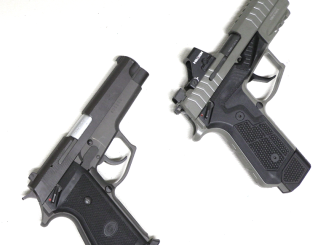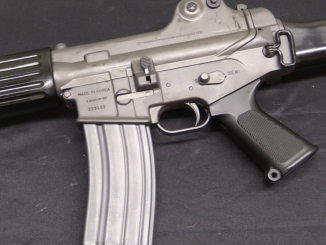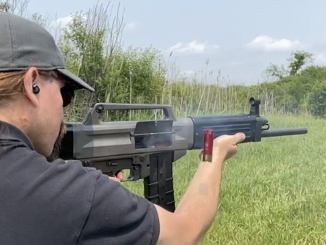During and after the Korean War, the South Korean military was armed with American weapons – M1 Garands, M1 Carbines, M3/M3A1 Grease Guns, and so on. In the 1970s they wanted to modernize their equipment, and looked to the US. South Korea purchased M16A1 rifles form Colt, and the Daewoo conglomerate obtained a license to manufacture them. Around the same time, they began a development program to produce a new array of Korean domestic small arms. The first result was the K1, a 5.56mm carbine (designated a submachine gun) to replace the Grease Gun.
The K1 used the AR15 gas system and AR15 fire control system, but couples with a right-side charging handle and a bolt carrier and recoil spring setup similar to the AR18, negating the need for a recoil spring in the stock and allowing the use of a wire collapsing stock. In its military form, it had a 10.4 inch barrel, and had both semiauto and full auto fire settings. The K1 remains in South Korean service today in the K1C form, updated to allow mounting of optics and other accessories.
In the 1980s and early 90s, the K1 was imported into the United States under several different names, including the K1A1, MAX-1, and (in the case of the rifle in today’s video) AR-110C. All had barrels lengthened to 16 inches to avoid the NFA, and were semiautomatic only.




Vehicle friendly arms tend to be frowned upon here as gang weapons… why cops don’t have them as well is beyond my understanding. But it is good that development based on necessity to prevent future problems isn’t dead. I could be wrong.
“why cops don’t have them as well is beyond my understanding.”
Old cop joke;
“We’re not getting the knife-resistant vests or the ARs this year for two reasons. One, the city social services director is against ‘militarizing the police’ and thinks such things ‘send the wrong message’.
“Two, the mayor needs a new limousine. The ashtrays are full on the one he got last year.
“And oh yes, they want to know why we’re not writing more parking tickets, because the city needs the revenue.”
I didn’t say it was a funny joke. But it is generally accurate.
cheers
eon
rotfl
true true, accurate also in my country/city (poland)
Swat teams don’t count? Or maybe they could auction off their free Mraps for some new sub guns.
Columbus OH PD SWAT had M1 Carbines and .357 revolvers for years, and did very well with them. There’s still a YT video of a Columbus SWAT sharpshooter shooting the gun apart in a would-be suicide’s hand with a scoped Carbine.
Then after 9/11 the new city administration decided they needed more firepower. So they graduated first to MP-5s, then Colt 9mm SMGs, and finally “tacticooled” M4s. And went from .357s to Beretta M9s to S&W M&P 9mms.
While the ability to put enough rounds into the target to get him to stop doing whatever made you conclude he needed to be shot to begin with is entirely sensible (see my comments on the 1986 FBI Miami shootout), the whole exercise is pointless if marksmanship is no longer considered “necessary” due to high magazine capacity.
Like LAPD, CPD became (in)famous for emptying a 15 round pistol magazine or a 30 round rifle or SMG magazine at a miscreant and maybe hitting him once. Leaving the rest of the magazine load winging downrange to hit whatever or whoever happened to be in its path. Several lawsuits have been quietly settled out of court for considerable sums as a result, again much like LAPD.
A “sustained firescreen”, “recon by fire”, or “Mad Minute” (call it what you please) is often a practical method in warfare, because generally anyone in front of your weapons is The Enemy.
In law enforcement, it’s a very different story. Generally, you don’t want to shoot anybody but the identified suspect. After all, everybody else behind him is generally hoping you’ll stop him from hurting them, which was why they called you to begin with.
cheers
eon
Some videos on internet are displaying some cops who have kind of “understood” the lesson :
Dumping a magazine in the back of a suspect who already surrendered reduce missed bullet count.
They did once have the High Standard Model 10 but (1) it was a shotgun and (2) it wasn’t reliable. It also couldn’t be safely fired by lefties.
There were probably several other firearms that seemed like good ideas but proved to have significant flaws and were abandoned.
I was stationed in South Korea in 1994-5 in the 2nd Combat Engineers, 2nd Inf. Div. We were all jealous of the ROK soldiers retractable stocks as we were all issued M16A2 at the time which are not armored vehicle friendly. However, the funniest thing about this video is that the Koreans made the K1 to replace the antiquated .45 Grease Gun in the 70’s/80’s. Take a guess at what sub machine gun was still issued to United States Army Engineer combat armored vehicle crews in Korea in the 1990’s??? Yup, the Grease Gun!!!
This proves again, as many other designs had done before starting with AR18, that the awkwardly designed “space age” M16 recoil system does not have to be. (For record, when first discovered existence of M16 fifty years ago I was real fan of it. But in time and awareness of possibilities, everything changed.)
What makes me wonder however, is why Koreans boxed themselves into aluminum ‘fohged’ (trying for real English pronunciation as I was used to hear) receiver not to mention quintessentially problematic direct gas. They may have changed to something else lately along the line of SCAR. Many receivers lately appear to be precision/die cast.
As far as I’ve been able to determine, the recoil-spring setup on the AR-15 was copied from the French MAS 38 SMG, just as its springloaded ejection-port dust cover was copied from the German MKb42/MP43/StG44 family. The dust cover was a good idea, the recoil spring setup, not so much.
Of course, the direct-impingement gas system nicked from the Swedish Ljungman AG42 wasn’t exactly the best idea Eugene Stoner ever had, either, which became painfully obvious when the “Matty Mattel” was used with ammunition loaded with ball powder.
It was things like this that caused me, when I was on an assignment requiring a possibly “emphatic” response, to break out the old reliable M1928 Thompson from the arms locker instead of an M16. Among other things, left on single-shot, out to 100 yards it was a bit more accurate than the Armalite.
cheers
eon
“Of course, the direct-impingement gas system nicked from the Swedish Ljungman AG42 wasn’t exactly the best idea Eugene Stoner ever had, either, which became painfully obvious when the “Matty Mattel” was used with ammunition loaded with ball powder.”
With all that being said direct gas is not necessarily catastrophe per se, for example MAS 49/56 seems to be well-liked by users https://modernfirearms.net/en/military-rifles/self-loading-rifles/france-self-loading-rifles/mas-1949-i-4956-eng/
With your level of knowledge you might know that there is a dramatic difference in conception of both Swedish AG42 and French MAS49/56 rifles versus Stoner’s device. They DO NOT allow gas into mechanism by acting plainly on face of carrier with quick went off. This does not cause excessive heating of breech mechanism and does not pose excessive cleaning/ lubrication requirements. Actually I do not know what was reason for dropping both mentioned designs except French rifle served for quite a while. I consider it a sound and rugged design.
“Swedish AG42”
It also spawned Egyptian Hakim self-loading rifle. They must consider it good enough, as similar in operation Rasheed (Rashid) self-loading carbine was created: https://modernfirearms.net/en/military-rifles/self-loading-rifles/egypt-self-loading-rifles/rasheed-eng/
““Matty Mattel””
For me, it looks that M16 is for many Americans… to use proper word… emotionally-tainted, that its both advantages and disadvantages are exaggerated. It probably could be explained by fact that it debuted during Second Indochina War, which is not considered reason for pride by Americans, if I am not mistaken.
M16 also, independently from all other features, introduced to U.S. forces, small-caliber inter-mediate cartridge, which some treated with disdain.
The recoil-spring setup was inspired by the Johnson 1941 rifle, as the whole bolt and carrier assembly was. In fact Johnson was also involved with Armalite. You should look at early AR10 prototypes in Joseph Putnam Evans’ book.
And the AR are not direct impingememt guns: their bolt carrier is the gas cylinder. A DI gun has the gaz tube blowing directly on the bolt carrier, not inside it.
Looking at the K1 action, why the Korean did not combine the square bolt carrier guided by the twin spring guide rods of AR18 with the lateral gas tube blowing in the bolt carrier without gas key of the first AR10 ?
To refresh myself on follow-up, this being K2 rifle I went to look again at this video.
https://www.youtube.com/watch?v=ZMdBnjeQIB8
First thing you notice is absence of gas tube and its replacement with long stroke gas piston. This is in my estimation WAY better design overall (not just for gas drive management). I also did some reading in discussion on YouTube version of this video. There is Korean weapons technician revealing weaknesses of K1 carbine; very much worth of reading.
There are few points that are needed to be retracted. First, Daewoo hadn’t entered gun industry until 1981, it was the state-owned Pusan Arsenal back then, which was then privatitzed and eventually became ‘Daewoo Precision Industries Ltd.’ later on. They are basically the same entity but worth noting. Second, the development of indigenous firearms at the time was solely managed by the ADD, which is equivalent to the DARPA in United States, so the manufacturer didn’t really get much opportunity to participate in designing.
Ian:
You have posted the idea of doing a video on Hill 80 for the Forgotten Weapons group on Patreon . I replied why not Hill 70 which the Canadians including my Grandfather took from the Germans at a terrible cost . My Granddad was gassed three times in that battle . WHY NOT DO A FORGOTTEN WEAPONS VIDEO ON THE GAS SHELLS (MARKED WITH YELLOW CROSSES) THE GERMANS FIRED AT THE ALLIES? AND ALSO THE ONES THE BRITS FIRED AT THE GERMANS . HOW DID THEY WORK? HOW DANGEROUS WERE THEY? UNDER WHAT CIRCUMSTANCES WOULD THEY WORK? WHAT HARM DID THEY DO?
GAS!
Does anybody know where I can find the schematics and/or specifications of this rifle? Or if they’re even unclassified by the ROK? The operating system is very similar to one that I’ve been designing and want to see if there’s anything that I haven’t thought about.